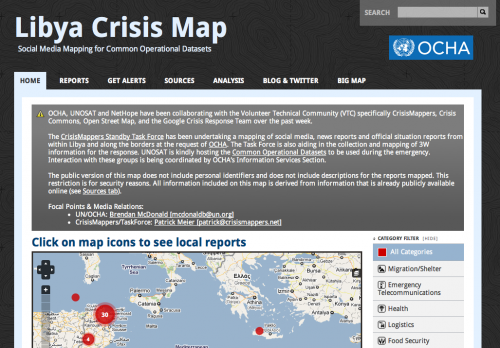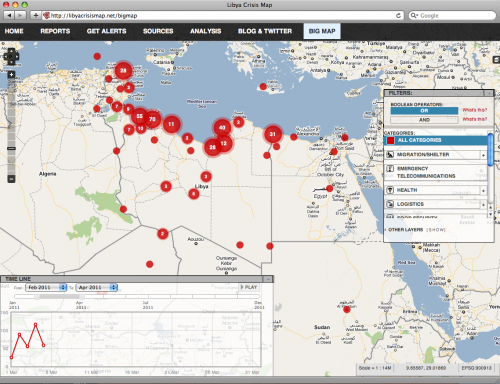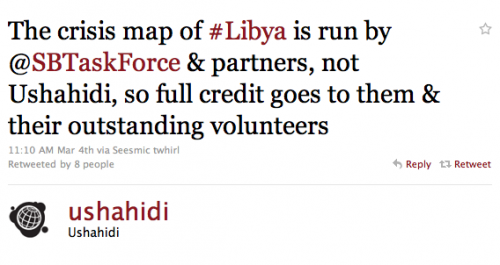On Tuesday, March 2nd, the UN Office for the Coordination of Humanitarian Affairs (OCHA) requested that the The Standby Volunteer Task Force be activated for Libya. The Task Force's Tech Team set up a password protected Ushahidi platform almost immediately and several days later launched a public version at OCHA's request.
 As I have noted in this blog post and this one, the launch of this crisis map for Libya has been a very different experience on the use of the Ushahidi platform in Haiti. But there are at least three other important points worth noting from the perspective of Ushahidi.
First, the Ushahidi team did not need to provide any technical support to the Task Force. Contrast this with the Haiti deployment where virtually all of Ushahidi's software developers were literally working around the clock for four weeks straight to keep the platform afloat because a considerable amount of customization was required on the fly. This time around, a larger technical community was available to play an instrumental role as the Task Force's Tech Team: George Chamales, Chris Roblee, John Etherton, Aaron Huslage, Rob Munro and Brian Hogg, for example. The platform was also a lot more robust this time around.
As I have noted in this blog post and this one, the launch of this crisis map for Libya has been a very different experience on the use of the Ushahidi platform in Haiti. But there are at least three other important points worth noting from the perspective of Ushahidi.
First, the Ushahidi team did not need to provide any technical support to the Task Force. Contrast this with the Haiti deployment where virtually all of Ushahidi's software developers were literally working around the clock for four weeks straight to keep the platform afloat because a considerable amount of customization was required on the fly. This time around, a larger technical community was available to play an instrumental role as the Task Force's Tech Team: George Chamales, Chris Roblee, John Etherton, Aaron Huslage, Rob Munro and Brian Hogg, for example. The platform was also a lot more robust this time around.
 Second, the customizations for Haiti had to be done from scratch. But thanks to the new version of the Ushahidi platform released just a few months ago, the Task Force's Tech Team was able to use a number of plugins (or apps) like the "Big Map" plugin developed by the Ushahidi-Liberia Team in Monrovia. It turns out that our colleagues at OCHA are using the Big Map interface almost exclusively because it provides the functionalities they need to carry out some comparative analysis of the data, which simply can't be done from the main map. At this point, a total of seven different plugins have been added to the map, more may be coming in the coming days.
Third, Ushahidi the company did not get confused for a humanitarian or human rights organization, which happened in Haiti. We made it very clear that this was not an Ushahidi Inc project, as the tweet below attests. Remember, the Ushahidi platform can be used to map all kinds of events and infrastructure, not just conflict. Check out this Burger Map of the US if you don't believe me.
Second, the customizations for Haiti had to be done from scratch. But thanks to the new version of the Ushahidi platform released just a few months ago, the Task Force's Tech Team was able to use a number of plugins (or apps) like the "Big Map" plugin developed by the Ushahidi-Liberia Team in Monrovia. It turns out that our colleagues at OCHA are using the Big Map interface almost exclusively because it provides the functionalities they need to carry out some comparative analysis of the data, which simply can't be done from the main map. At this point, a total of seven different plugins have been added to the map, more may be coming in the coming days.
Third, Ushahidi the company did not get confused for a humanitarian or human rights organization, which happened in Haiti. We made it very clear that this was not an Ushahidi Inc project, as the tweet below attests. Remember, the Ushahidi platform can be used to map all kinds of events and infrastructure, not just conflict. Check out this Burger Map of the US if you don't believe me.
 If you'd like to help out with the crisis mapping efforts in Libya or future crisis mapping efforts, please follow this link. The Task Force is composed of skilled professionals, including humanitarian professionals who are new to crisis mapping. If you have no experience, you will get hands on training from the most experienced volunteers. This is a great way to learn new marketable skills and help the world at the same time.
Finally, it is worth noting that the success of this deployment has a lot to do with the fact that the Task Force already had trained volunteers on standby and clear processes as well as workflows. In other words, the Task Force has worked hard on getting the non-technical requirements addressed rather than focusing exclusively on the technology. As Chris Blow, a long time friend of Ushahidi's put it in a previous post, the Ushahidi platform is only 10% of the solution.
If you'd like to help out with the crisis mapping efforts in Libya or future crisis mapping efforts, please follow this link. The Task Force is composed of skilled professionals, including humanitarian professionals who are new to crisis mapping. If you have no experience, you will get hands on training from the most experienced volunteers. This is a great way to learn new marketable skills and help the world at the same time.
Finally, it is worth noting that the success of this deployment has a lot to do with the fact that the Task Force already had trained volunteers on standby and clear processes as well as workflows. In other words, the Task Force has worked hard on getting the non-technical requirements addressed rather than focusing exclusively on the technology. As Chris Blow, a long time friend of Ushahidi's put it in a previous post, the Ushahidi platform is only 10% of the solution.
 I can definitely say that the field of crisis mapping has come a long way since the Haiti deployment. Why? Because we are focusing on people and processes first (all the other stuff) and technology second. As the technology gets easier and easier to use, the success of an Ushahidi deployment will fall increasingly on how well groups fare with all the other stuff they need to do to make their project successful.
As director of crisis mapping at Ushahidi, I catalyze crisis mapping efforts, share best practices and lessons learned, catalyze volunteer technical communities like the Standby Task Force, and interface with the humanitarian, human rights and media communities. This experience is particularly insightful for Ushahidi, we get important feedback on what works and doesn't work, both on the technical and non-technical side. The lessons we learn from these deployments allow us to provide even better services to organizations we formally partner with. This is becoming increasingly important given our stated strategic goals for 2011.
I can definitely say that the field of crisis mapping has come a long way since the Haiti deployment. Why? Because we are focusing on people and processes first (all the other stuff) and technology second. As the technology gets easier and easier to use, the success of an Ushahidi deployment will fall increasingly on how well groups fare with all the other stuff they need to do to make their project successful.
As director of crisis mapping at Ushahidi, I catalyze crisis mapping efforts, share best practices and lessons learned, catalyze volunteer technical communities like the Standby Task Force, and interface with the humanitarian, human rights and media communities. This experience is particularly insightful for Ushahidi, we get important feedback on what works and doesn't work, both on the technical and non-technical side. The lessons we learn from these deployments allow us to provide even better services to organizations we formally partner with. This is becoming increasingly important given our stated strategic goals for 2011.
 As I have noted in this blog post and this one, the launch of this crisis map for Libya has been a very different experience on the use of the Ushahidi platform in Haiti. But there are at least three other important points worth noting from the perspective of Ushahidi.
First, the Ushahidi team did not need to provide any technical support to the Task Force. Contrast this with the Haiti deployment where virtually all of Ushahidi's software developers were literally working around the clock for four weeks straight to keep the platform afloat because a considerable amount of customization was required on the fly. This time around, a larger technical community was available to play an instrumental role as the Task Force's Tech Team: George Chamales, Chris Roblee, John Etherton, Aaron Huslage, Rob Munro and Brian Hogg, for example. The platform was also a lot more robust this time around.
As I have noted in this blog post and this one, the launch of this crisis map for Libya has been a very different experience on the use of the Ushahidi platform in Haiti. But there are at least three other important points worth noting from the perspective of Ushahidi.
First, the Ushahidi team did not need to provide any technical support to the Task Force. Contrast this with the Haiti deployment where virtually all of Ushahidi's software developers were literally working around the clock for four weeks straight to keep the platform afloat because a considerable amount of customization was required on the fly. This time around, a larger technical community was available to play an instrumental role as the Task Force's Tech Team: George Chamales, Chris Roblee, John Etherton, Aaron Huslage, Rob Munro and Brian Hogg, for example. The platform was also a lot more robust this time around.
 Second, the customizations for Haiti had to be done from scratch. But thanks to the new version of the Ushahidi platform released just a few months ago, the Task Force's Tech Team was able to use a number of plugins (or apps) like the "Big Map" plugin developed by the Ushahidi-Liberia Team in Monrovia. It turns out that our colleagues at OCHA are using the Big Map interface almost exclusively because it provides the functionalities they need to carry out some comparative analysis of the data, which simply can't be done from the main map. At this point, a total of seven different plugins have been added to the map, more may be coming in the coming days.
Third, Ushahidi the company did not get confused for a humanitarian or human rights organization, which happened in Haiti. We made it very clear that this was not an Ushahidi Inc project, as the tweet below attests. Remember, the Ushahidi platform can be used to map all kinds of events and infrastructure, not just conflict. Check out this Burger Map of the US if you don't believe me.
Second, the customizations for Haiti had to be done from scratch. But thanks to the new version of the Ushahidi platform released just a few months ago, the Task Force's Tech Team was able to use a number of plugins (or apps) like the "Big Map" plugin developed by the Ushahidi-Liberia Team in Monrovia. It turns out that our colleagues at OCHA are using the Big Map interface almost exclusively because it provides the functionalities they need to carry out some comparative analysis of the data, which simply can't be done from the main map. At this point, a total of seven different plugins have been added to the map, more may be coming in the coming days.
Third, Ushahidi the company did not get confused for a humanitarian or human rights organization, which happened in Haiti. We made it very clear that this was not an Ushahidi Inc project, as the tweet below attests. Remember, the Ushahidi platform can be used to map all kinds of events and infrastructure, not just conflict. Check out this Burger Map of the US if you don't believe me.
 If you'd like to help out with the crisis mapping efforts in Libya or future crisis mapping efforts, please follow this link. The Task Force is composed of skilled professionals, including humanitarian professionals who are new to crisis mapping. If you have no experience, you will get hands on training from the most experienced volunteers. This is a great way to learn new marketable skills and help the world at the same time.
Finally, it is worth noting that the success of this deployment has a lot to do with the fact that the Task Force already had trained volunteers on standby and clear processes as well as workflows. In other words, the Task Force has worked hard on getting the non-technical requirements addressed rather than focusing exclusively on the technology. As Chris Blow, a long time friend of Ushahidi's put it in a previous post, the Ushahidi platform is only 10% of the solution.
If you'd like to help out with the crisis mapping efforts in Libya or future crisis mapping efforts, please follow this link. The Task Force is composed of skilled professionals, including humanitarian professionals who are new to crisis mapping. If you have no experience, you will get hands on training from the most experienced volunteers. This is a great way to learn new marketable skills and help the world at the same time.
Finally, it is worth noting that the success of this deployment has a lot to do with the fact that the Task Force already had trained volunteers on standby and clear processes as well as workflows. In other words, the Task Force has worked hard on getting the non-technical requirements addressed rather than focusing exclusively on the technology. As Chris Blow, a long time friend of Ushahidi's put it in a previous post, the Ushahidi platform is only 10% of the solution.
 I can definitely say that the field of crisis mapping has come a long way since the Haiti deployment. Why? Because we are focusing on people and processes first (all the other stuff) and technology second. As the technology gets easier and easier to use, the success of an Ushahidi deployment will fall increasingly on how well groups fare with all the other stuff they need to do to make their project successful.
As director of crisis mapping at Ushahidi, I catalyze crisis mapping efforts, share best practices and lessons learned, catalyze volunteer technical communities like the Standby Task Force, and interface with the humanitarian, human rights and media communities. This experience is particularly insightful for Ushahidi, we get important feedback on what works and doesn't work, both on the technical and non-technical side. The lessons we learn from these deployments allow us to provide even better services to organizations we formally partner with. This is becoming increasingly important given our stated strategic goals for 2011.
I can definitely say that the field of crisis mapping has come a long way since the Haiti deployment. Why? Because we are focusing on people and processes first (all the other stuff) and technology second. As the technology gets easier and easier to use, the success of an Ushahidi deployment will fall increasingly on how well groups fare with all the other stuff they need to do to make their project successful.
As director of crisis mapping at Ushahidi, I catalyze crisis mapping efforts, share best practices and lessons learned, catalyze volunteer technical communities like the Standby Task Force, and interface with the humanitarian, human rights and media communities. This experience is particularly insightful for Ushahidi, we get important feedback on what works and doesn't work, both on the technical and non-technical side. The lessons we learn from these deployments allow us to provide even better services to organizations we formally partner with. This is becoming increasingly important given our stated strategic goals for 2011.